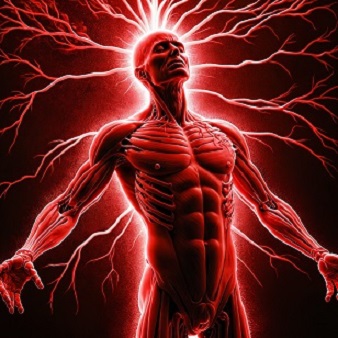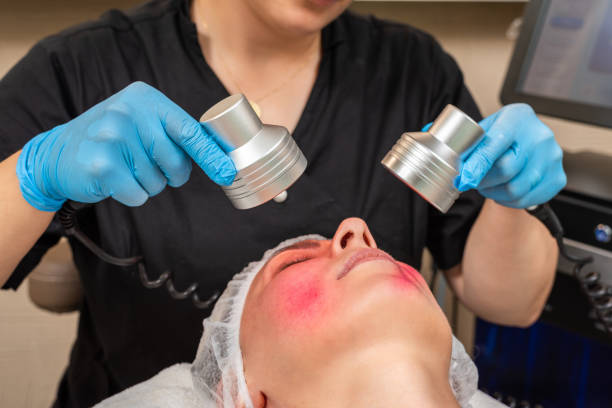I’ve found using red light therapy both before and after workouts offers distinct benefits. Before a workout, it boosts ATP production, enhancing energy and oxygen utilization, which improves performance. Post-workout, it accelerates muscle recovery, reduces inflammation, and aids muscle repair. The therapy works by stimulating mitochondrial activity, increasing blood flow, and reducing chronic inflammation. At-home devices that deliver red and near-infrared wavelengths are convenient and effective for daily use. Choosing a device with proper coverage and FDA clearance is essential for best results. The evidence shows its potential to improve athletic outcomes and overall well-being to a great extent. Discover more insights ahead.
Benefits for Athletes
Athletes frequently experience enhanced physical performance, faster recovery times, and reduced muscle soreness when incorporating red light therapy into their fitness routines. From my own research and analysis, it’s evident that red light therapy offers significant physiological benefits. By emitting wavelengths between 630 nm and 850 nm, red light therapy penetrates tissues to stimulate cellular processes, particularly in the mitochondria, enhancing energy production and accelerating cellular repair.
One of the primary mechanisms is the increase in adenosine triphosphate (ATP) production. ATP is essential for muscle contractions and overall energy metabolism. With more ATP available, muscles can perform more efficiently and with greater endurance. This translates into improved strength, speed, and overall physical performance.
Moreover, red light therapy aids in faster muscle recovery post-workout. It reduces inflammation and promotes blood flow, which are essential for delivering nutrients and oxygen to the muscles. This process helps in quicker regeneration of muscle fibers, thereby reducing muscle soreness and allowing for more frequent and intense training sessions.
Red light therapy also plays a significant role in preventing and alleviating delayed onset muscle soreness (DOMS). By reducing oxidative stress and inflammation at the cellular level, it mitigates the micro-damage caused by strenuous exercise. This not only helps in faster recovery but also minimizes the downtime between workouts.
Pre-Workout Advantages
Incorporating red light therapy before a workout can greatly enhance performance by increasing ATP production and optimizing cellular energy. When I use red light therapy pre-workout, I leverage its ability to stimulate mitochondrial function, resulting in a boost of ATP—the cellular energy currency. This elevation in energy availability directly correlates with improved endurance, strength, and overall exercise performance.
Research indicates that red light therapy stimulates cytochrome c oxidase in the mitochondria, enhancing oxygen consumption and ATP synthesis. This biochemical enhancement translates to tangible improvements in my workout sessions. By energizing my muscle cells, I find that my time-to-exhaustion is noticeably extended, and I can sustain higher intensity levels for longer periods.
Moreover, red light therapy enhances blood flow and reduces oxidative stress, both of which are essential for peak physical performance. Enhanced blood flow ensures that my muscles receive adequate oxygen and nutrients, which are vital for sustained activity. Reduced oxidative stress means less cellular damage during intense exercise, allowing me to push my limits without compromising my muscle integrity.
Additionally, the anti-inflammatory effects of red light therapy prepare my muscles for exertion. By preemptively reducing inflammation, I experience less stiffness and more flexibility, which is important for both performance and injury prevention. The cumulative effect is a more efficient, powerful workout, where I can achieve my fitness goals faster and more effectively.
Post-Workout Recovery
After an intense workout, red light therapy accelerates muscle recovery and reduces inflammation, allowing me to return to peak performance more quickly. Utilizing red light post-exercise can greatly mitigate delayed onset muscle soreness (DOMS) and support faster muscle repair. Here’s why this method works so effectively for post-workout recovery:
Red light therapy, through specific wavelengths, penetrates deep into the muscle tissues, enhancing cellular repair mechanisms. This process helps in reducing muscle stiffness and soreness by promoting better blood circulation and reducing oxidative stress. The increased blood flow delivers more oxygen and nutrients to the muscles, expediting the repair of microtears caused by strenuous exercise.
Incorporating red light therapy into my recovery routine has several tangible benefits:
- Reduced Inflammation: Red light decreases the inflammatory response in muscles, which is essential for faster recovery.
- Enhanced Muscle Repair: The therapy stimulates mitochondrial activity, boosting ATP production, necessary for muscle healing.
- Pain Relief: It alleviates pain by reducing oxidative stress and inflammatory markers.
- Improved Flexibility: Regular use improves joint mobility and muscle flexibility, reducing the risk of injury.
- Accelerated Recovery: Faster muscle recovery means shorter downtime between workouts, enhancing overall performance.
Science Behind the Therapy
Red light therapy operates at the cellular level by stimulating mitochondrial activity, which boosts energy production and cellular repair. When red light, especially within the 630 nm to 850 nm wavelength range, penetrates the skin, it directly interacts with the mitochondria, the cell’s powerhouse. This interaction enhances the production of adenosine triphosphate (ATP), the molecule responsible for storing and transferring energy within cells. Increased ATP production allows cells to operate more effectively, repair damage more rapidly, and replicate more efficiently.
Clinical studies have demonstrated that red light therapy diminishes chronic inflammation, a prevalent issue that can hinder athletic performance and recovery. By regulating the inflammatory response, red light therapy helps to lessen pain and expedite the healing of muscles, connective tissues, and bones. This is especially advantageous post-workout, as it facilitates quicker recovery and reduces the occurrence of delayed onset muscle soreness (DOMS).
Furthermore, red light therapy boosts blood flow and collagen production. Improved blood flow ensures that nutrients and oxygen are transported more efficiently to muscle tissues, encouraging faster and more effective recovery. Collagen production, conversely, fortifies connective tissues, which can enhance joint mobility and diminish the risk of injuries.
From a critical perspective, the benefits of red light therapy are not immediate but rather cumulative. Regular use before and after workouts can result in substantial enhancements in physical performance and recovery over time. By comprehending the underlying science, I can make more educated decisions about integrating red light therapy into my fitness regimen to optimize its benefits.
At-Home Therapy Devices
At-home red light therapy devices offer a crucial and effective solution for enhancing physical performance, accelerating recovery, and promoting overall well-being. These devices are designed to deliver red and near-infrared (NIR) wavelengths, typically ranging from 630 nm to 850 nm, which penetrate the skin and stimulate cellular processes. The convenience of using these devices at home means I can easily incorporate them into my daily routine, whether I’m preparing for a workout or recovering afterward.
I’ve found that using these devices provides several benefits:
- Enhanced Muscle Recovery: The red light helps reduce muscle damage and inflammation, speeding up recovery times.
- Improved Physical Performance: Regular use before workouts can enhance strength, speed, and endurance.
- Pain Relief: Targeted light therapy can alleviate joint and muscle pain, making it easier to stay active.
- Skin Health: Red light therapy promotes collagen production, improving skin tone and texture.
- Convenience: I can use the therapy devices at home, fitting treatments into my schedule with ease.
When comparing at-home devices, it is crucial to take into account power output, wavelength range, and treatment area. For example, PlatinumLED’s BIOMAX series panels deliver a high energy output and cover a larger area, making them ideal for more extensive treatment sessions. The modular design means I can link multiple panels for increased coverage, which is particularly beneficial for full-body treatments.
Choosing the right device can have a significant impact on the effectiveness of the therapy. By integrating red light therapy into my fitness regimen, I’ve noticed improvements not just in my physical performance but also in my overall health and well-being.
Conclusion
Incorporating red light therapy into my fitness routine has undeniably enhanced my performance and recovery. Whether used pre-workout to boost endurance and strength or post-workout to alleviate soreness and speed up healing, the benefits are scientifically backed and substantial. With at-home therapy devices making it more accessible, I’m convinced this innovative approach is a game-changer for any serious athlete. Don’t overlook the science—red light therapy can be a pivotal addition to your regimen.




